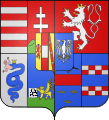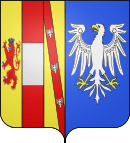Austria-Este
| House of Hasburg-Este Casa d'Asburgo-Este Haus von Habsburg-Este House of Austria-Este | |
|---|---|
| Former royal house | |
|
Motto: "Dextera Domini exaltavit me" (English: "The right hand of the Lord is exalted") | |
| Country |
Former countries
|
| Parent house | Houses of Este and Habsburg-Lorraine |
| Titles |
|
| Style(s) |
"Imperial and Royal Highness" "Majesty" "Grace" |
| Founded | 1771 |
| Founder | Ferdinand, Duke of Breisgau & Maria Beatrice d'Este, Duchess of Massa |
| Final ruler | Francis V, Duke of Modena |
| Current head | Prince Lorenz of Belgium |
| Deposition | 1859 (Annexation of Italy) |
| Ethnicity | Austro-Italian |
The House of Hasburg-Este (Italian: Casa d'Asburgo-Este; German: Haus von Habsburg-Este), holders of the title of Archduke of Austria-Este (Italian: Arciduca d'Austria-Este; German: Erzherzog von Österreich-Este), is a noble house and cadet branch of the House of Este and the House of Habsburg, created in 1771 with the marriage between Duke Ferdinand of Habsburg-Lorraine and the Duchess Maria Beatrice d'Este, only daughter of the Duke of Modena Ercole III d'Este. After the death of Ercole III in 1803, the Este's direct line ended, and the Habsburg-Estes inherited his possessions in Italy.
History
Origins
Ercole III d'Este, the last Este duke of Modena in the direct male line, was deposed in 1796 by the French as his Italian principality was incorporated into the Cisalpine Republic, later the Napoleonic Kingdom of Italy. In 1814 French rule in Italy ended. Modena was to be returned to his daughter Mary Beatrice d'Este and her son Archduke Francis of Austria-Este after Duke Ercole's death. Duke Ercole had been compensated with the duchy of Breisgau in southern Germany: the Habsburgs ceded this province to him, in anticipation of its falling eventually to the Habsburg family again, since Ercole's sole daughter was married to a cadet Habsburg, Archduke Ferdinand of Austria-Este. Duke Ercole died in 1803 and Breisgau was indeed inherited by his daughter and her husband, but they soon (1805) lost it to the expanding Grand Duchy of Baden.
Rule on the Emilia
The family, cognatically descended from the Estes, ruled the Duchy of Modena and Reggio again from 1814 to 1859, using the names Asburgo-Este (Habsburg-Este) and its variants, along with the subsidiary titles Duke of Reggio, of Mirandola, of Massa, Prince of Carrara and Lunigniana, and, since 1847, Duke of Guastalla. In 1859 the principality lost its independence and was incorporated into the newly united Kingdom of Italy, and Francis V, the last duke, was deposed. Francis V, Duke of Modena (1846–59, died 1875) withdrew to his estates in Austria.
After the death of his mother in 1840, Francis was considered the legitimate heir to the English and Scottish thrones by the Jacobites (with the regnal title King Francis I). When Francis died at Vienna on November 20, 1875, his family became extinct in the male line. His heir general and heir-of-the-blood was his niece, Archduchess Maria Theresa of Austria-Este (died 1919), who then was married with Prince Ludwig of Bavaria (they later became King and Queen of Bavaria). The heir-general of the Estes continues in their descendants, and the present heir is Franz, Duke of Bavaria.
After Unification and current status
However, Francis V had decided to retain the Este name in the Habsburg family, and left most of his huge estate to his young cousin Archduke Franz Ferdinand of Austria, with certain conditions, one of which is that the heir and future heirs use the name of Este.[1] The non-territorial property of the Este family thus fell to the line of Archduke Charles Louis, younger brother to then Emperor Francis Joseph, Austria-Este then becoming a sort of "secundogeniture" title within the Austrian imperial family.
Although the first heir, Archduke Franz Ferdinand (1863-1914), was not a descendant of the last Este duchess, Mary Beatrice of Modena), he took the name Austria-Este.[1] In 1896 he became the heir presumptive of the Austrian Empire and, according to the terms of the secundogeniture, could not combine the Austria-Este inheritance with that of the main line of the House of Habsburg (i.e., the Austro-Hungarian Empire, but he was assassinated 28 June 1914 in Sarajevo before becoming emperor. Because Franz Ferdinand's children were born in morganatic marriage (see House of Hohenberg), on 16 April 1917 Emperor Charles I of Austria, as head of the House of Habsburg, issued letters patent conferring the name, arms and patrimony of Austria-Este on his son, Archduke Robert, and his future issue according to masculine primogeniture.[2] Through his mother Zita of Bourbon-Parma, Robert happened to be a descendant of Duke Ercole III of Modena as well, and thus the blood of the last Este dukes was joined with the name Austria-Este.
On Robert's death his eldest son, Archduke Lorenz, born 1955, by his wife, Princess Margherita of Savoy-Aosta, succeeded him in that role.[3] He is married to Princess Astrid of Belgium, the only daughter of King Albert II of Belgium. Since the throne of Belgium is heritable by females (and males no longer have precedence over females), Princess Astrid is an heir of Belgium immediately after the issue of King Philippe of Belgium. As such, her husband Archduke Lorenz of Austria-Este, was in 1995 elevated to the additional title of Prince of Belgium.[3] The children of the couple are, since 1991, titled Archduke (Archduchess) of Austria-Este and Prince(ss) of Belgium. The eldest of these is Prince Amedeo of Belgium, Archduke of Austria-Este, born 1986.[3]
Family trees
Archdukes of Austria (and current order of succession)
Maria Theresa, Queen of Hungary, Archduchess of Austria (1717–1780) × Francis I (1708–1765) | +-- Ferdinand, Duke of Modena (1754–1806) | × Maria Beatrice d'Este, Duchess of Massa, Princess of Carrara (1750–1829) | | | +-- Ferdinand of Austria-Este, Duke of Modena (1781–1850) | +-- Karl (1785–1809) | +-- Marie Ludovika (1787–1816) | × Franz I of Austria | +-- Leopold II (1747–1792) × Maria Luisa of Spain (1745–1792) | +-- Franz I (1768–1835) × Marie Ludovika, daughter of his uncle Ferdinand Karl × Maria Theresa of Two Sicilies (1772–1807) | +-- Ferdinand I (1793–1875) +-- Marie Louise, Empress of the French +-- Maria Leopoldina, Empress of Brazil +-- Franz Karl (1802–1878) × Sophie of Bavaria (1805–1872) | +-- Franz Joseph (1830–1916) | × Elisabeth in Bavaria ("Sissi" of Austria) +-- Maximilian I of Mexico (1832–1867) +-- Maria Anna Caroline Pia of Austria (1835–1840) +-- Ludwig Victor (1842–1919) (Ludwig Victor was younger than Karl Ludwig) +-- Karl Ludwig (1833–1896) × Maria Annunziata of Bourbon-Sicily | +-- Franz Ferdinand, Archduke of Austria-Este (1863–1914) +-- Otto (1865–1906) × Maria Josepha of Saxony | +-- Karl I (1887–1922), Last Emperor of Austria | × Zita of Bourbon-Parma (1892–1989) | | | +-- Otto (1912–2011) | | × Regina of Saxe-Meiningen (1925–2010) | | | | | +--Karl (1961- ), Current head of the House of Habsburg-Lorraine | | | × Baroness Francesca Thyssen-Bornemisza de Kászon (1958-) | | | | | | | +-- Ferdinand Zvonimir von Habsburg (1997-) | | | | | +--Georg von Habsburg (1964-) | | × Duchess Eilika of Oldenburg (1972-) | | | | | +-- Károly-Konstantin (2004-) | | | +-- Robert, Archduke of Austria-Este (1915–1996) | | × Margherita of Savoy-Aosta (1930– ) | | | | | +-- Maria Beatrix (1954– ) | | | | | +-- Lorenz, Archduke of Austria-Este (born 1955), | | | × Astrid of Belgium (1962– ) | | | | | | | +-- Archduke Amedeo of Austria-Este, Prince of Belgium (1986– ), 1st Heir | | | | x Nobile Elisabetta Maria Rosboch von Wolkenstein (1987– ) | | | | | | | +-- Maria Laura (1988– ) | | | +-- Joachim (1991– ) 2nd Heir | | | +-- Luisa Maria (1995– ) | | | +-- Laetitia Maria (2003– ) | | | | | +-- Gerhard (1957– ) 3rd Heir | | | | | +-- Martin (1959– ) 4th Heir | | × Princess Katharina von Isenburg (1971– ) | | | | | | | +-- Bartholomäus (2006– ) 5th Heir | | | +-- Emmanuel (2008– ) 6th Heir | | | +-- Helene (2009– ) | | | +-- Luigi (2011– ) 7th Heir | | | | | +-- Isabella (1963– ) | | | +-- Felix (1916–2011) | +-- Carl Ludwig (1918–2007) | +-- Rudolph (1919–2010) | +-- Maximilian (1895–1952)
Dukes of Modena
Rinaldo III d'Este
× Charlotte, Duchess of Braunschweig-Lüneburg
|
+-- Francesco III (1698–1780)
× Charlotte d'Orléans
|
+-- Ercole III (1727–1803)
× Maria Teresa Cybo-Malaspina, Duchess of Massa, Princess of Carrara
|
+-- Rinaldo Francesco d'Este (1753)
+-- Maria Beatrice (1750–1829)
× Ferdinand Karl, Archduke of Austria
|
+-- Josef Franz (1772)
+-- Francis IV, Duke of Modena (1779–1846)
| × Maria Beatrice of Savoy
| |
| +-- Maria Theresia of Austria-Este (1817–1886)
| | × Henri of Bourbon-Artois, Count of Chambord
| +-- Franz V of Austria-Este (1819–1875)
| | × Adelgunde of Bavaria
| | |
| | +-- Anna Beatrice of Austria-Este (1848–1849)
| |
| +-- Ferdinand Karl of Austria-Este (1821–1849)
| | × Elizabeth Austria (granddaughter of Emperor Leopold II)
| | |
| | +-- Maria Theresia of Austria-Este (1849–1919)
| | × Ludwig III, King of Bavaria
| |
| +-- Maria Beatrix of Austria-Este (1824–1906)
| × Juan of Borbón, Count of Montizon
| |
| +-- Carlos of Borbón, Duke of Madrid (1848–1909)
| +-- Alfonso Carlos of Borbón, Duke of San Jaime (1849–1936)
|
+-- Ferdinand of Austria-Este (1781–1850)
+-- Maximilian Joseph of Austria-Este (1782–1863)
|
+-- Karl of Austria-Este (1785–1809), Archbishop of Esztergom
+-- Maria Theresia of Austria-Este (1773–1832)
| × Vittorio Emanuele I of Savoy; had issue
|
+-- Josepha of Austria-Este (1775–1777)
+-- Maria-Leopoldine of Austria-Este (1776–1848)
| × Ludwig, Count von Arco; had issue
|
+-- Maria Antonia (1784–1786)
+-- Marie Ludovika of Austria-Este (1787–1816)
× Franz II, Holy Roman Emperor
Coat of arms
-

Ferdinand of Austria-Este (1754–1806)
-

Francis IV of Austria-Este (1779–1846)
-

Francis V of Austria-Este (1819–1875)
-

Francis Ferdinand of Austria-Este (1863–1914)
-

Robert of Austria-Este (1915–1996)
See also
References
- 1 2 "Almanach de Gotha", Maison de Habsbourg-Lorraine, (Gotha: Justus Perthes, 1944), pp. 50-52, (French).
- ↑ "Wiener Zeitung, 5 May 1917". Politische Chronik der Österreichisch-ungarischen monarchie: 277. 1917.
- 1 2 3 Genealogisches Handbuch des Adels, Fürstliche Häuser XVI. "Haus Österreich". C.A. Starke Verlag, 2001, pp. 90-92. ISBN 978-3-7980-0824-3.